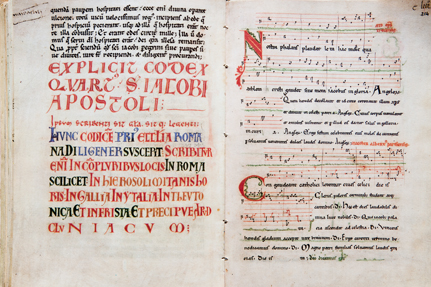The "Codex Calixtinus" goes back to Saint James’ Cathedral
13 years ago
One year after its disappearance –on July 5th 2011–, the Codex Calixtinus was found in a junk room in Milladoiro, a locality near Santiago. The most emblematic publication related to the Way to Saint-James is again in Santiago’s cathedral.

Pages of the "Codex Calixtinus"
One day before the anniversary of the news of its theft, the Codex Calixtinus was recovered by the National Police in a garage used as junk room, in Milladoiro. The garage belonged to an electrician who had worked in the cathedral and who had been fired after having falsified a labour document.
Despite this fact, the electrician continued going to the cathedral daily, there he alledgedly stole a good deal of documentation related to the religious responsible people of the cathedral, canons’ personal letters, access keys and various dependences, publications and art works from the temple. During the registering of the electrician’s properties, the police found more than one million euro in cash, what makes us consider the value of the stolen material.
Written in Latin during the central decades of the 12th century, the Codex Calixtinus is the reference book for Saint James’ sphere and also the oldest one dealing exclusively with this theme. Initial and initiation text fostered by Santiago’s church in the time of the archbishop Diego Gelmírez in order to consolidate the city possibilities as apostolic see and to spread the principles of Saint James pilgrimage as an European experience.
It is considered one of the monuments to the continental culture in the Middle Ages, a jewel as attractive as exciting for anyone wishing to get deeper in Saint James’ subject, but also for those interested in the general knowledge of the Middle Ages and the historical Spanish and European development. Furthermore, it has consolidated an aim considered essential in Compostela: the strengthening of Santiago as the second great centre of the Christianity, after Rome.
Authorship and Contents
This text, of considerable length, is divided in five books: a wide relation of liturgical texts advocated to Saint James, some of them with revealing contributions to understand the pilgrimage; the miracles worked by Saint James in different places along Europe; the transfer of Saint James body from Palestine to Galicia and the obstacles to put it in a definite sepulchre; the coming to Spain of the Franc-German emperor Charlemagne so as to open the way to the apostolic tomb; and the famous pilgrim’s guide from France to Santiago. It finishes with a serial of musical compositions to honour the apostle, some miracle else and some texts justifying the work.
Given the good relations of the Cluniac Pope Calixtus II –1119-1124– with Saint James sanctuary, of which he was the greatest pontifical benefactor, Compostela’s Church agreed to attribute this work to the pontiff. It was sought juicy dividends of authentication, promotion and prestige for Saint James’ cult and pilgrimage.
This is the reason why Calixtus II is regarded as the author of the first and longest of the five books, of the work of the miracles of the second book and even of the transfer of Saint James’ body to Galicia. From this false attribution comes the fact that the books were spread with the name of Codex Calixtinus. They were even quoted by some author as Pseudo-Calixtinus. Actually, the authorship of the work cannot be known with certainty, yet some French influence seems to be evident. In fact, the origins of Aymeric Picaud are French, and this author is believed to have written at least the fifth book, where the Way is described for the first time.
Miniatures and Capitularies
The miniatures of Compostela’s text do not reach the amount and quality of the other two medieval codices, yet they provide the pages with information, colour and fluency. Most of the capitularies count on great artistic value too, as the initial of Compostela’s Codex, which represents the pope Calixtus writing the book.
According to Díaz y Díaz, the elaboration of the Calixtinus would have included copyists, poets, musicians, tellers and fabulists, ‘as well as theologians and writers with strange skills, representing, at least in their final products, the most selected in the cultured world of the peninsula, then identified as the Kingdom of Leon, as well as in the north and centre of France, and even in some other countries.’
Las Bodeguillas de Santiago
12 years ago
Los barrios compostelanos de San Roque, San Lázaro y Santa Marta acogen tres de (+)
A tavern which has become a gastronomic benchmark
13 years ago
La Bodeguilla de San Roque was born in 1986 at an old tavern. It is a restaurant (+)


 See previous news
See previous news


